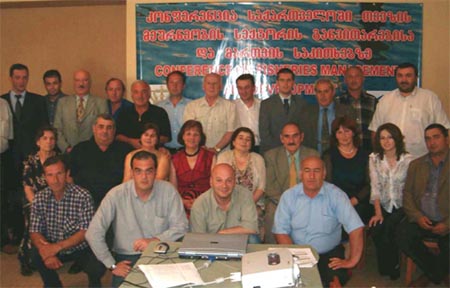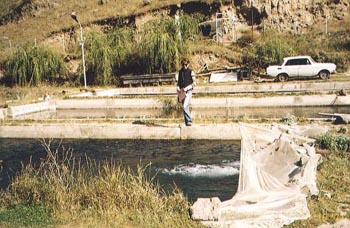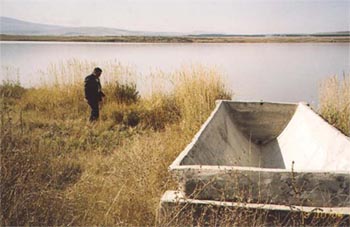
Participants to the Technical Session of the Conference on Fisheries Management and Development, Tbilisi, Georgia, 15-16 June 2005
Maia Metreveli
Georgia, a former member of Soviet Republic, became an independent state in 1991. The country is bordering the Black Sea on the east side. Georgia is rich in hydrobiological resources. The Black Sea and the numerous rivers, reservoirs and lakes make the country suitable for marine and inland capture fisheries and aquaculture activities.
THE CURRENT SITUATION
While aquaculture in Georgia was well established in the 1950s, the number of aquaculture farms and hatcheries for restocking of inland waterbodies has gradually declined.
The official register of the Department of Fisheries (DoF) contains 84 inland water bodies (ponds, lakes and reservoirs) that are used for fisheries purposes. It is estimated that there are some 50 unregistered small waterbodies that are used for fisheries in addition to these official figures. In early 2004, it was found that there are at least 81 farms involved in fish pond production. In addition, at least six hatcheries are reproducing a range of species, including Cyprinus carpio (common carp), Hypophthalmichthys molitrix (silver carp), Ctenopharyngodon idella (grass carp), Oncorhynchus mykiss (rainbow trout), Varicorhinus capoeta (barb), Carassius carassius (crucian carp) and Silurus glanis (catfish).
The area of ponds, lakes and reservoirs currently being restocked with fingerlings is approximately 3 200 ha and total aquaculture production may reach up to 1 000 tonnes of fish annually (among which are about 600 tonnes of common carp and 250 tonnes of grass carp). The total production of the 35 trout farms is small and estimated, in recent years, to be in the order of 120 tonnes of fish annually.
Most of the fingerlings (particularly those of common and grass carp) used by aquaculturists are produced in Georgia. Some aquaculturists produce their own fingerlings, while others have to buy fingerlings from nearby hatcheries. Unfortunately, a number of inland waterbodies (including ponds) cannot be restocked periodically because the owners or operators cannot afford to purchase fingerlings.
Approximately 70 percent of the eggs, fry and fingerlings for trout farms are produced in the country while the remainder is imported. Fingerlings of carp, trout and other species produced domestically are generally considered to be of poor quality. The absence of research programmes for genetic improvement, fish health management and fish feeding is considered to be one of the main reasons.
The lack of good-quality feed for trout culture in Georgia is another main constraint to the development of the sub-sector. Fishmeal for the production of fish feed is generally imported from Turkey and/or Denmark, which makes it very expensive (about US$1.20 per kg). Aquaculturists sometimes also import commercial fish feed of well-known brands at high prices. Georgia’s capture fisheries fleet catches considerable volumes of anchovy and other marine species, some of which could be used for the preparation of fishmeal and aquaculture feeds, but at present the anchovy caught is largely exported for hard currency. This practice prevents Georgian aquaculturists from taking advantage of the raw material produced within the country for the preparation of the required quantities of fish feed.

Akhaltsikhe trout Farm
Maia Metreveli
Pond culture of common and grass carp benefits from fertilization with both organic and nonorganic fertilizers. Unfortunately, at present, the majority of aquaculturists cannot afford to invest in fertilizers because they do not have enough working capital or access to formal credit sources.
Aquaculture is considered to have good prospects for future development in Georgia. In the short term, the production of carp in ponds, lakes and reservoirs is being encouraged to support the domestic market demand, which is far from being satisfied. Demand for low-priced fish in rural areas and small towns is particularly high. Doubling the annual aquaculture production of carp to almost 2 000 tonnes seems a possibility with only slight improvements in access to and availability of fertilizers, fish feed and fingerlings. In the longer term, the establishment of an aquaculture extension and monitoring system, improvements in the supply of high-quality fingerlings and access to credit would make it possible for an annual production of around 5 000 tonnes of fish to be achieved.
The demand for trout at the domestic market seems to be showing a positive trend. As current trout culture is constrained largely by limited access to and availability of domestically produced fish feed and fingerlings, it would be possible to increase domestic production of this species in a relatively short period provided that these two constraints are lifted.
FAO ASSISTANCE TO CAPTURE FISHERIES AND AQUACULTURE DEVELOPMENT IN GEORGIA
In 2003, the Government of Georgia requested FAO to provide technical assistance for the sustainable development and management of the fisheries sector. FAO approved the project TCP/GEO/2904 (A) entitled "Strengthening the capacity of the Department of Fisheries to support fisheries sector rehabilitation". Between August 2004 and July 2005, this project assisted the Department of Fisheries (DoF) of Georgia’s Ministry of Agriculture with the following outputs, namely:
1. Review of the Currents Status of Fisheries Resources and Utilization in Georgia,
2. Master Plan for fishery sector development in Georgia (2005-2020),
3. Action Plan for fishery sector management and development in Georgia (2005-2008),
4. A final draft version of the Law of Georgia for Fisheries and Aquaculture,
5. A pilot Fishery Statistics System, and
6. Training of DoF staff through international study-tours, workshops and in-country training courses.
The policy and legal framework development process involved three large participatory workshops attended by all major fishery sector stakeholders, many consultations with sectoral and non-sectoral stakeholders, international expert advice and discussions with potential donor agencies. The Review, Master Plan and Action Plan have been agreed upon by the Ministry of Agriculture and are currently shepherded through the further governmental approval process by the Director of Fisheries, David Iakobidze. The final draft version of the Law is still under discussion between the various ministries involved in aquatic resources management. All documents are available in Georgian and English languages from the Ministry of Agriculture and they will be published in English as FAO Fisheries Circular No. 1007 before the end of 2005. The title of the Circular will be "Fisheries and aquaculture in Georgia: current status and planning".
THE MASTER PLAN AND THE AQUACULTURE SECTOR
The Master Plan for fishery sector development in Georgia (2005-2020) states the following long term objective for the aquaculture sector: to develop an aquaculture sector that produces the variety and quantity of goodquality products demanded by the market in an environmentally sustainable and socially and economically viable manner.
Specific objectives for aquaculture development in the country are:
1. Develop an aquaculture sector that produces fish that domestic consumers and the export market demand.
2. Produce at least 2 000 tonnes annually in the aquaculture sector by technology enhancement, increased access to: (a) good-quality and reasonably priced feeds and fingerlings; and (b) credit, microfinance and insurance.
3. Increase diversity in the aquaculture sector, using a variety of species (trout, carp, oysters, mussels, mullet, flatfish, sturgeon and the mollusc rapana), culture areas (such as ponds, cages and tanks) and systems (extensive, intensive and integrated aquaculture with agriculture and livestock raising).
4. Support the establishment of aquaculture associations that work on the development of codes of good practice and play an active role as sectoral representative bodies in discussions and negotiations with the Government of Georgia.
5. Obtain national-level self-sufficiency in fry, fingerling and fish feed production through private hatcheries and feed factories that have access to cheap credit and quality advice and support from national fisheries and agriculture research institutes.
6. Promote the role of aquaculture in rural poverty alleviation, community development and the achievement of food security in Georgia.
7. Develop and use technology that encourages economically viable culture systems of oysters, mussels and other marine organisms in the Black Sea coastal region.
8. Practise aquaculture in an ecologically sustainable manner and monitor its effects on genetic diversity and ecosystem integrity in order to minimize adverse consequences on the ecosystem and social and economic conditions.
9. Develop aquaculture based on native species; the introduction of non-native species or genetically altered stocks may be possible only after potential associated risks have been scientifically assessed and government approval has been obtained.
10. Develop and implement codes of good farm and fish health management practices in aquaculture.
11. Establish and implement a cost-effective fish health monitoring system with government support.

Akhalgaliagi carp Farm
Maia Metreveli
The Action Plan for fishery sector management and development in Georgia (2005-2008) calls for action in the field of aquaculture by the Government, donor agencies, research institutes and private sector aquaculture farmers. Prioritized activities for the period up until 2008 are: fingerlings and feed research, poverty alleviation through aquaculture development and the establishment of demonstration farms for capacity building in aquaculture. FAO has been approached to continue assisting the country in some of these areas.
Copies of the above mentioned documents and more news on FAO ongoing fishery sector assistance to Georgia can be obtained from: Raymon van Anrooy, Fishery Planning Analyst of FAO ([email protected]) or Mamuka Meskhi, FAO Assistant Representative in Georgia ([email protected]).
| [10] Raymon Van Anrooy Fishery Development Planning Service FAO Fisheries Department, Rome e - mail: [email protected] |